Washington State is a veritable sanctuary for a multitude of Birds of Prey. These raptors, including hawks, eagles, falcons, and owls, are an integral part of the area’s vibrant ecosystem. The state’s diverse range of habitats, from its coastal areas to its mountainous regions and expansive forests, provides ample opportunities for these magnificent creatures to thrive, and in turn, creates ideal conditions for birdwatching.
Washington State, rich in varied habitats from coastal lines to mountains and forests, hosts a fascinating diversity of Birds of Prey. These raptors, encompassing hawks, eagles, falcons, and owls, contribute significantly to the state’s ecological richness and offer ample opportunities for bird watching.
Types of Birds of Prey In Washington
| Bird’s Name | Size | Frequency in Washington | Best Place to Spot in Washington | Best Viewing Season |
|---|---|---|---|---|
| Bald Eagle | Large | Very Common | Near water bodies | All year |
| Golden Eagle | Large | Common | Mountainous regions | All year |
| Red-Tailed Hawk | Medium | Very Common | Roadside fence posts and trees | All year |
| Cooper’s Hawk | Medium | Common | Forested and suburban areas | All year |
| Sharp-shinned Hawk | Small | Common | Wooded areas | All year |
| Northern Harrier | Medium | Common | Open fields and marshes | All year |
| Swainson’s Hawk | Medium | Common | Open country | Summer |
| Peregrine Falcon | Medium | Common | Urban areas and tall buildings | All year |
| Merlin | Small | Uncommon | Various habitats | All year |
| American Kestrel | Small | Common | Perched on telephone wires | All year |
| Osprey | Large | Common | Near lakes, rivers, and coasts | All year |
| Northern Goshawk | Large | Uncommon | Undisturbed tracts of coniferous or deciduous forest | All year |
| Turkey Vulture | Large | Common | Groups often seen soaring | Warmer months |
| Rough-legged Hawk | Medium | Uncommon | Open habitats | Winter |
| Western Screech Owl | Small | Common | Various habitats, including suburban areas | All year |
| Great Horned Owl | Large | Common | Forests, deserts, and city parks | All year |
| Barn Owl | Medium | Common | Open habitats like fields and farmland | All year |
| Snowy Owl | Large | Rare | Washington | Winter |
| Short-Eared Owl | Medium | Common | Open habitats | Dusk and dawn |
| Long-Eared Owl | Medium | Uncommon | Wooded habitats | Winter |
| Burrowing Owl | Small | Uncommon | Grasslands and agricultural areas | Daytime |
| Barred Owl | Large | Common | Mature forests | All year |
| Northern Saw-whet Owl | Small | Uncommon | Coniferous forests and thickets | All year |
When it comes to hawks in Washington, also spotted are ferruginous hawks and broad-winged hawks. The ferruginous hawk scientific name Buteo regalis, known for its striking rusty-brown plumage, is a captivating sight as it soars through the skies of the state particularly western Washington. See our complete guide to Washington Hawks here.
Washington State Birds of Prey Photo Guides
Bald Eagle (Haliaeetus leucocephalus)

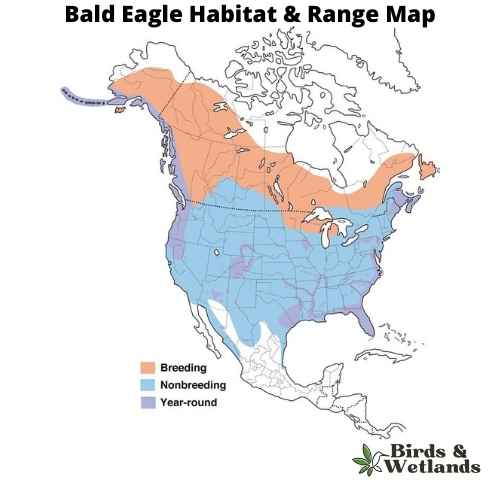
Bald Eagle Sound
Scientific Name: Haliaeetus leucocephalus
Length: 28–40 in
Wingspan: 5 ft 11 in and 7 ft 7 in
Weight: 6.6 -13.9 lb
The Bald Eagle, primarily found in Canada and Alaska, is instantly identifiable by its white head, dark brown body, yellow beak, and a piercing cry. Its sharp, orange-yellow eyes aid in efficient night hunting.
Predominantly residing in North America, occasionally venturing into Asia and Europe, it thrives near water bodies. It perches atop trees, providing a bird’s-eye view of its prey. It feeds on fish, carrion, small mammals like rabbits and squirrels, and reptiles. Hunting involves a swift downward swoop to seize the prey, carrying it back to the nest.
Bald Eagles are monogamous, forming lifelong pairings. They construct vast nests from sticks, lined with moss or grasses. They typically lay 1-3 eggs annually, which hatch around 35 days later. The fledglings leave the nest roughly 6 weeks after hatching, but continue to rely on their parents for nourishment for a further 5-6 months, until they become proficient hunters.
Golden Eagle (Aquila chrysaetos)


Golden Eagle Sound
Scientific Name:Aquila chrysaetos
Length: 26 to 40 in
Wingspan: 5 ft 11 in to 7 ft 8 in
Weight: 8.9 and 14.0 lb
The Golden Eagle is a large bird of prey known for its strength, speed, and hunting prowess.
Adult Golden Eagles are large birds, and are named for the golden-brown plumage on their heads and necks, which contrasts with their darker brown body feathers. Their eyes, legs, and bill are all yellow.
These eagles prefer open, rugged terrain, including mountains, hills, grasslands, and deserts. They are most often found in areas that provide good opportunities for soaring and hunting.
Golden Eagles have a varied diet but primarily prey on small to medium-sized mammals such as rabbits, hares, and ground squirrels. They are also capable of taking larger prey, like young deer or livestock, but these are not typically part of their diet.
Golden Eagles build large nests or eyries, usually on cliffs or in tall trees. The nests are often reused and added to each year, becoming enormous structures over time. The female typically lays 1 to 4 eggs, which both parents incubate.
Red-tailed Hawk (Buteo jamaicensis)

The Red-tailed Hawk is a large bird of prey that is commonly found across North America. This species is part of the genus Buteo, which is often referred to as the “true hawks,” and includes more than two dozen species of raptors.
Red-tailed Hawks have a robust size, ranging from 18 to 26 inches in length and sporting a wingspan that can exceed 4 feet. They have a broad, rounded set of wings and a short, wide red tail. This species is most easily recognized by its rich, rust-colored tail, which gives it its common name. However, juvenile hawks might not yet have this distinctive feature.
Their feathers are generally dark brown on their dorsal side (back) with a lighter, often speckled, ventral side (front). The intensity and pattern of their plumage can vary significantly based on their age and geographic location, as there are about 14 recognized subspecies of Red-tailed Hawks.
As for their diet, Red-tailed Hawks are carnivores and have a broad diet that includes rodents, ground rabbits, reptiles, and other birds. They are skilled hunters that typically sit on high perches and use their keen eyesight to spot potential prey. Once they have identified a target, they swoop down to capture it with their powerful talons.
Red-tailed Hawks mate for life and build nests high off the ground, often in tall trees or on cliff edges. Their nests are made of sticks and can be quite large. They typically lay 1-3 eggs per year, which are incubated by both parents.
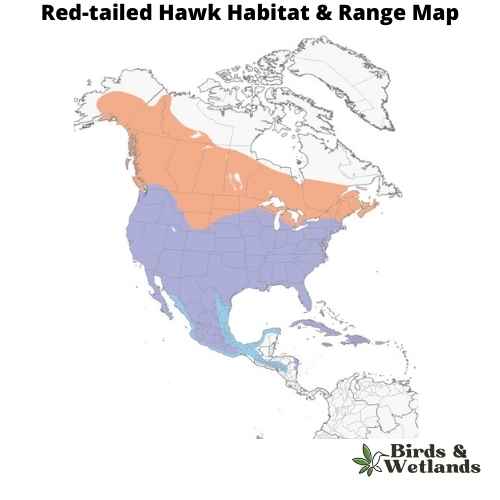
Red-tailed Hawk Sound
Cooper’s Hawk (Accipiter cooperii)

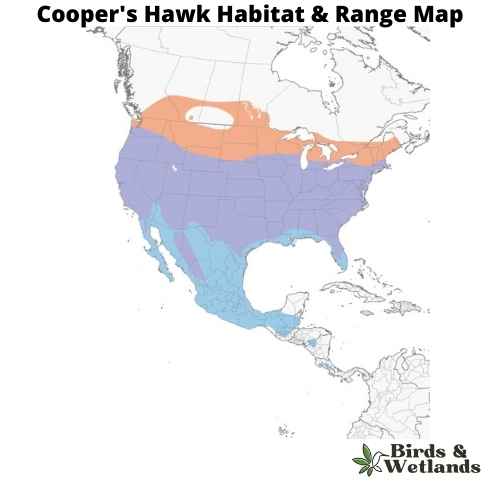
Listen:
The Cooper’s Hawk is a medium-sized bird of prey native to North America. Known for its agility and speed, it is part of the Accipitridae hawk species, which also includes other hawks, eagles, and kites.
Cooper’s Hawks are typically about 14 to 20 inches in length, with a wingspan ranging from 27 to 36 inches. They are known for their distinctive long, rounded tails and short, rounded wings. They have a steely blue gray top, with rusty bars on their underparts and thick, dark bands on their tails.
The Cooper’s Hawk is a skilled predator, primarily hunting birds and small mammals. They are adept at hunting in both dense forests and open areas, often catching prey mid-air in high-speed pursuits. They have also been known to visit the backyard bird feeder, not for the seed, but to prey on the smaller birds that gather there.
Cooper’s Hawks often build nests in dense tree canopies where they are well concealed. The female usually lays 3 to 5 eggs, and both parents share incubation duties. The young hawks fledge after about a month but will stay close to the nest, relying on their parents for food as they learn to hunt.
Sharp-shinned Hawk (Accipiter striatus)

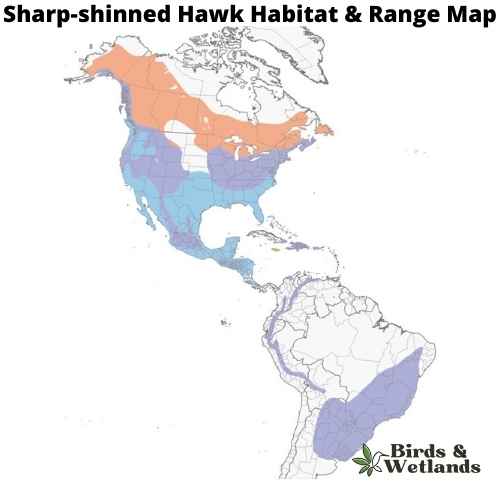
Listen:
The adult bird is brown on top and white underneath, with a dark brown band across its chest. It has short, rounded wings and a long tail that makes it look larger than it actually is. Adult sharp shinned hawks have black eyes, which are surrounded by white feathers. The female Sharp-shinned Hawk is browner than the male, who has darker brown markings on his back.
Sharp-shinned Hawks prefer open country for their habitat, including fields and meadows where they can hunt for mice and other small animals. They can be found throughout the United States but are most common in the east.
Sharp-shinned Hawks eat mostly small birds, such as sparrows and warblers, as well as small mammals such as mice and gophers. They catch prey by surprise using their incredible speed and agility, diving out of the sky at speeds up to 200 mph.
Sharp-shinned Hawks have an unusual hunting style for hawks—they prefer to catch their prey from perches above trees or telephone wires, rather than swooping down from above like most other hawks do and can often be seen hunting near bird feeders.
Northern Harrier (Circus hudsonius)

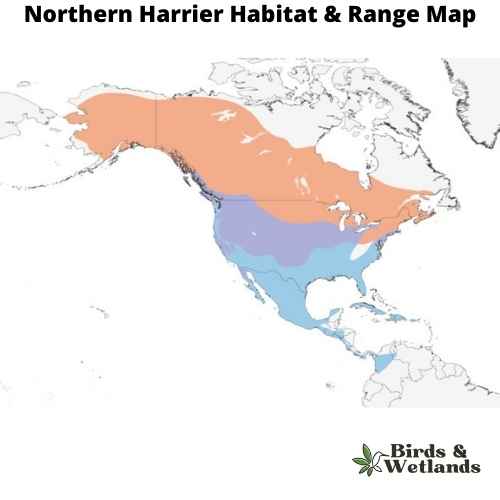
Listen:
The Northern Harrier is a medium-sized, slender hawk.
Adult birds are gray above, with pale bars on the wing feathers and white markings on the underwings and a white rump patch. The breast is barred with black and white, and the belly is streaked with brown.
They prefer open areas, such as grasslands and marshes, but can be found in almost any open habitat except dense woods.
Northern Harriers are opportunistic hunters that feed on small mammals such as mice, voles and rabbits as well as birds including quail, grouse and ducks. They hunt by flying low over open spaces such as fields or marshes.
Northern harrier nests on the ground in lowlands or hillsides near water bodies. It lays two to four eggs which hatch after 24 days of incubation by both parents. The chicks fledge after 30 days of hatching and remain dependent on their parents for another three weeks during which they learn how to fly.
Swainson’s Hawk (Buteo swainsoni)
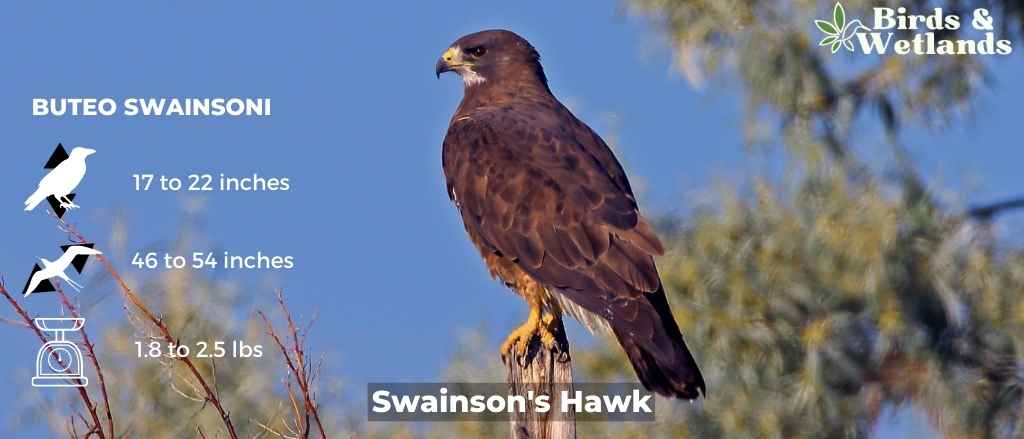
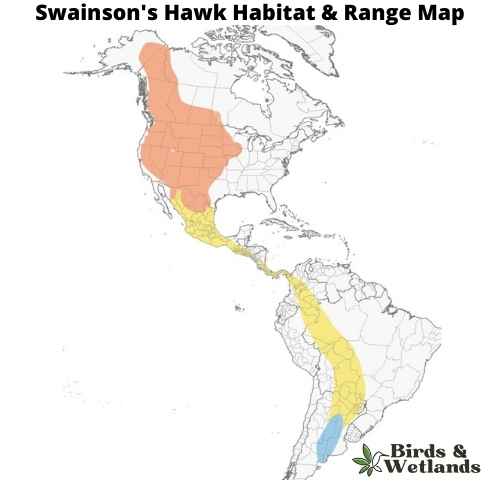
Listen: Swainson’s Hawk
Swainson’s Hawk is a medium-sized hawk that is found in North America and South America, Scientific Name: Buteo swainsoni.
The bird has a blue-gray plumage with a dark brown back, wings, and tail. It also has a white chest and belly. The beak and feet are black, but the eyes are yellow. They are often confused with Cooper’s Hawk because of similar coloring, but Swainson’s Hawks have wider tails and longer wings than their cousin species.
These birds eat small rodents such as gophers and mice. They also eat insects like grasshoppers and crickets during the summer months when they’re plentiful. They sometimes steal prey from other birds of prey such as Northern Harriers who hunt the same prey.
Swainson’s Hawks build nests on rocky cliffs near water sources where they can find food easily. They lay three to five eggs that hatch after about two months into fluffy brown baby hawks who leave the nest after about three weeks (or when they’re big enough).
Peregrine Falcon (Falco peregrinus)


Peregrine Falcon Sound
Scientific Name: Falco peregrinus
Length: 14.2-19.3 in
Wingspan: 39.4-43.3 in
Weight: 530-1600 g
Known for its blue-gray plumage and unique cheek bars, the Peregrine Falcon stands as a beacon of power and swiftness. Despite its modest size, it reigns as the world’s fastest creature, reaching staggering speeds up to 240 mph during hunting dives.
Its diet mainly includes birds, occasionally bats, caught in an enthralling aerial display of agility and precision. Adapting to diverse habitats, this bird graces every continent except Antarctica, finding home in environments from city skyscrapers to towering cliffs.
Peregrine Falcons, monogamous in nature, often pair for life, expressing their bonds through complex courtship flights filled with intricate aerial maneuvers. They construct simple scrape nests on high ledges, often without adding materials.
Their parenting duties are shared, from egg incubation to feeding and caring for the chicks, ensuring their offspring are ready to take on the skies in their own time.
Merlin (Falco columbarius)

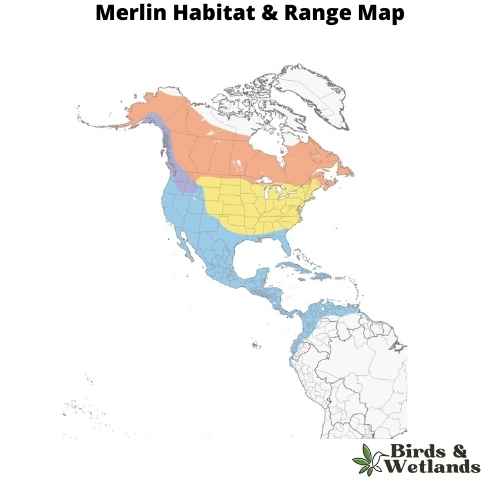
Merlin Sound
Scientific Name: Falco columbarius
Length: 9.4–13.0 in
Wingspan: 20–29 in
Weight: 5.8 – 8.1 ozz
The Merlin is a small, robust falcon known for its blue-gray or dark brown upperparts and thinly streaked, buff to orange underparts. Unlike other falcons, it has faint facial markings, offering a more uniform look.
This compact bird, renowned for its hunting prowess, chases down small birds in mid-air, exemplifying its impressive speed and agility.
Residing across northern North America, Europe, and Asia, the Merlin prefers open or semi-open landscapes. Rather than constructing their own nests, they tend to reuse old crow or raptor nests, or choose to nest on the ground in open habitats.
During courtship, males perform elaborate aerial displays. Both parents share egg incubation duties, with the male also responsible for feeding the family, reflecting the Merlin’s fascinating role in the biodiversity of its ecosystems.
American Kestrel (Falco sparverius)
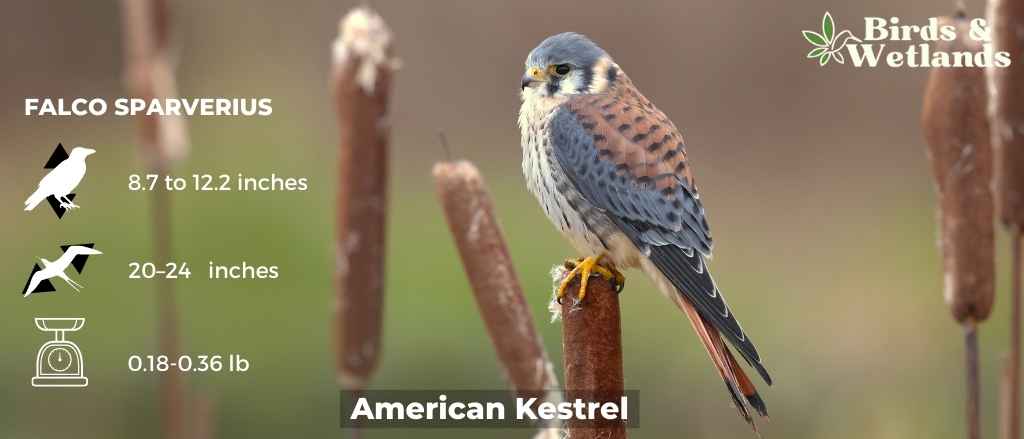
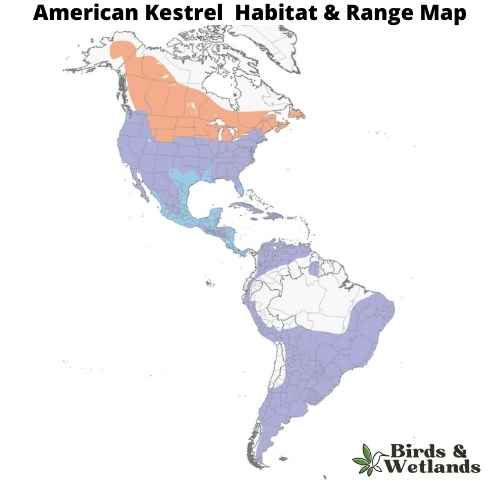
American Kestrel Sound
Scientific Name: Falco sparverius
Length: 8.7 to 12.2 in
Wingspan: 20–24 in
Weight: 3.0–5.8 oz
The American Kestrel, often recognized as the smallest and most brightly colored falcon in North America, exhibits a stunning array of rufous, blue and gray hues in its plumage. This bird, ranging in size from a mere 22 to 31 cm, carries distinct black facial markings that contrast with its white cheeks and has blue gray wings. Despite its small stature, the American Kestrel is a formidable predator, employing a unique hunting strategy that involves hovering at a height before swooping down on prey, primarily consisting of insects, small mammals, and occasionally small birds.
Residing predominantly in North and South America, the American Kestrel exhibits a preference for open habitats such as meadows, grasslands, and deserts. They are also found in both urban and suburban environments, nesting in cavities in trees, cliffs, buildings, and other structures. Kestrels are monogamous, with both sexes participating in the courtship displays that involve aerial acrobatics and feeding rituals. Nesting duties are a shared responsibility, with the male initially scouting for suitable locations and the female making the final selection. Both parents contribute to the incubation of the eggs and care of the young, ensuring the perpetuation of this captivating species.
Osprey (Pandion haliaetus)

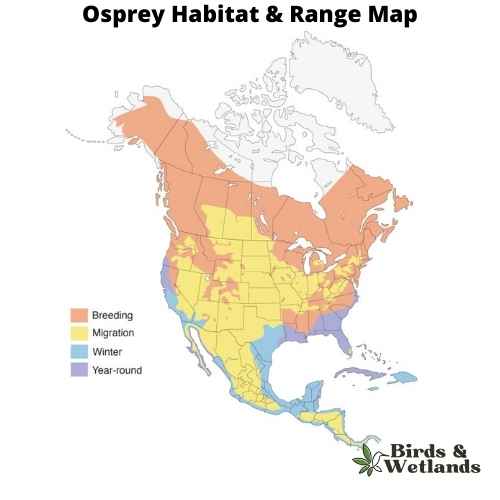
Osprey Sound
Scientific Name: Pandion haliaetus
Length: 50–66 cm (19+1⁄2–26 in)
Wingspan: 127–180 cm (50–71 in)
Weight: 0.9–2.1 kg (2 lb 0 oz – 4 lb 10 oz)
The Osprey, a fascinating bird of prey, is universally known for its exceptional hunting prowess and striking physical characteristics. Osprey are dark brown hawks on the upperparts, contrasting beautifully with the predominantly white underparts, and a distinctive dark band that stretches across the eyes towards the sides of its head.
Equipped with specialized talons and a reversible outer toe, the Osprey’s hunting strategy involves a spectacular plunge-dive into bodies of water, often emerging with a fish securely gripped in its claws.
Found on every continent except Antarctica, the Osprey is a cosmopolitan species favoring habitats near water bodies such as lakes, rivers, and coastal areas, reflecting its piscivorous diet. This bird has a diet almost exclusively of fish, making it a unique member of the raptor family and often referred to as the sea hawk or fish hawk. They locate their prey from the air, often hovering before plunging feet-first to capture a fish. When it comes to breeding, Ospreys are monogamous, often mating for life.
They construct large, bulky nests made of sticks, lined with softer materials, and prefer elevated or isolated areas such as treetops or artificial structures like utility poles. Both parents share the responsibility of incubating the eggs and rearing the chicks.
Northern Goshawk (Accipiter gentilis)


Listen:
The Northern Goshawk is a medium-sized hawk that is found in North America, Europe and Asia. It has brown eyes, a large sharp beak, and dark brown plumage on its upperparts and head, with white underparts that are spotted with brown barring. Its tail feathers are grayish-black with a dark band near the tip.
Northern goshawks eat squirrels, rabbits, grouse, woodchucks and other small mammals like voles or mice (which they often eat whole). They will also take larger prey such as deer fawns or even adult deer if they have no other choice. They have broad wings with long feathers that allow them to glide through the air when they catch their prey. They also have an excellent sense of smell which helps them locate their food source.
The Northern Goshawk builds its nest in a tree cavity or on a ledge, usually on the edge of an open area so it can easily see prey below. The female lays 3 to 5 eggs over two days and incubates them for 28 to 30 days while the male brings food to her every few hours until they hatch. The young fledge after about 6 weeks and leave the nest when they are about 10 weeks old.
Turkey Vulture (Cathartes aura)

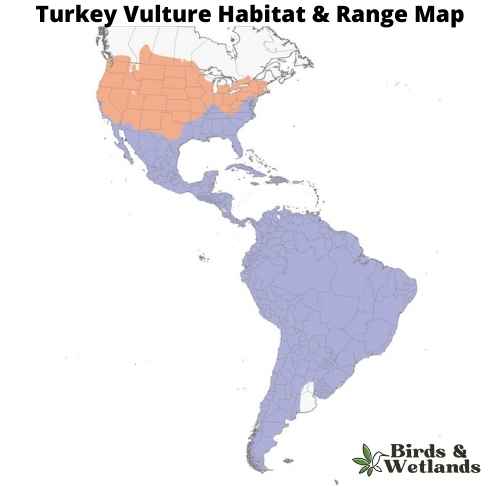
Turkey Vulture Sound
Scientific Name: Cathartes aura
Length: 24–32 in
Wingspan: 63–72 in
Weight: 1.8 to 5.3 lb
Turkey vultures are large birds that are easily recognizable by their bald heads, which are black in coloration, and by the patch of red skin below their beaks. It is white with black spots on the wings and tail. It has a bald head and a hooked beak that is black in coloration.
Turkey vultures live in the Americas, Europe, Africa, and Asia. They can be found in deserts, grasslands, forests and swamps. Turkey vultures are found throughout North America and parts of Central America and South America. In the U.S., they can be found across the country, but most commonly in the southwest region.
Turkey vultures eat carrion—dead animals’ remains such as dead deer, sheep, cows, horses and other large mammals that have been killed by other predators, such as coyotes or foxes. They do not hunt live prey.
Rough-legged Hawk (Buteo lagopus)

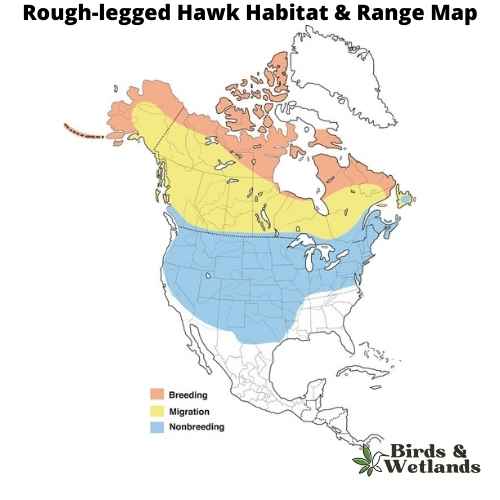
Rough-legged Hawk Sound
The Rough-legged Hawk is a large, raptor that is native to North America. It is also known as the American Rough-legged Hawk. Scientific Name: Buteo lagopus
The Rough-legged Hawk is a medium-sized hawk with a distinctive appearance, with dark brown feathers on its back and light brown feathers on its underside and broad thin wings. The hawk’s legs are also covered in dark feathers, which help to distinguish it from other species of hawk. The tail is barred with black and white. They have yellow eyes and dark feet.
Rough-legged Hawks hunt from above ground level, swooping down to catch its prey in its talons. When hunting for food, they prefer to eat small mammals such as squirrels and rabbits but will also eat birds if there aren’t any small mammals available. Although they eat a variety of small animals including birds, rodents, bats and reptiles, they rely heavily on fish for food during breeding season because it provides them with protein and calcium needed to produce eggs.
Western Screech-Owl (Western Screech-Owl)
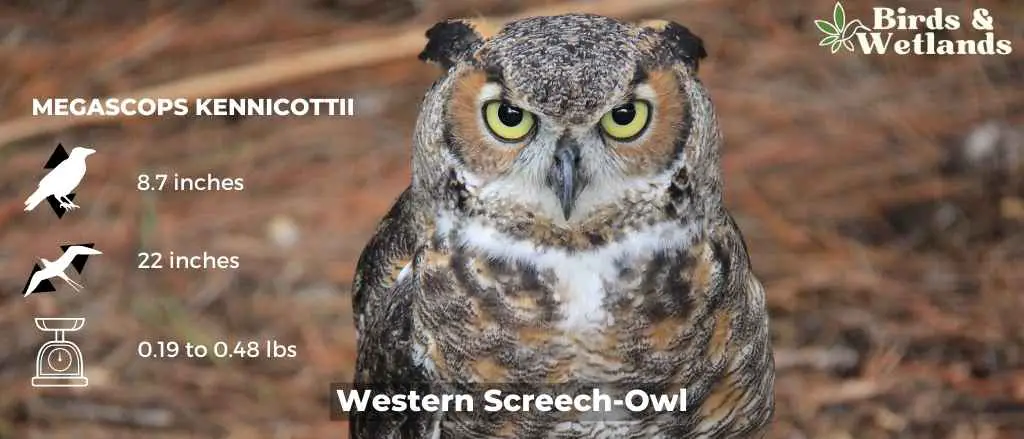
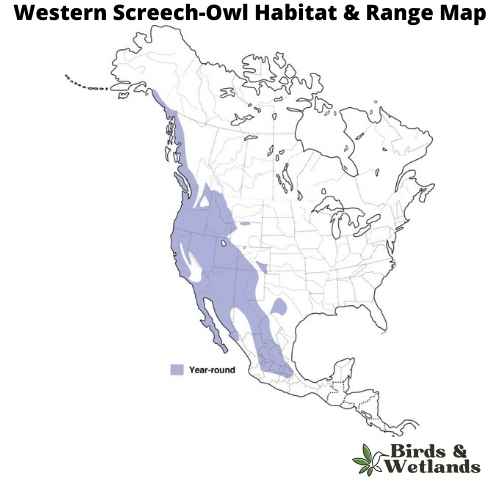
Western Screech-Owl Sound
Scientific Name: Megascops kennicottii
Length: 22 cm (8.7 in)
Wingspan: 55 cm (22 in)n
Weight: 88 to 220 g (3.1 to 7.8 oz)
The Western Screech-Owl, or Megascops kennicottii, is a small species of owl native to North and Central America. Western Screech-Owls are nocturnal predators, and its diet primarily consists of small mammals, birds, insects, and occasionally fish.
This owl is medium-sized compared to other screech-owls. It has a compact, stocky body, and is often recognized by its large head with yellow eyes surrounded by greyish-brown facial disks. The plumage is generally a mixture of grey and brown, with intricate patterns of spots and streaks that provide excellent camouflage against tree bark.
These owls prefer mixed woodland habitats, including deciduous forests and semi-open areas with trees. They often nest in tree cavities, but will also readily take to nest boxes if available. These birds are primarily non-migratory, and once they’ve established a territory, they tend to stay within the same area year-round.
Great Horned Owl (Bubo virginianus)

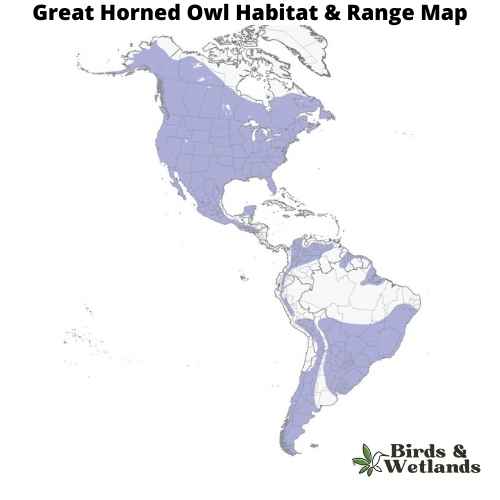
Great Horned Owl Sound
Scientific Name:Bubo virginianus
Length: 18.1-24.8 in
Wingspan: 39.8-57.1 in
Weight: 32.1-88.2 oz
The Great Horned Owl is a large owl with long wings and a large head. It’s one of the most common owls in North America.
Great Horned Owls are large, stocky birds with soft feathers that are gray to brown on their backs and white on their chests. Their faces are characterized by two black “ear” tufts, which can be raised or flattened depending on the owl’s mood. The eyes are yellow, orange, or red in color.
The habitat of the Great Horned Owl is a variety of different environments such as forests and deserts. They also live near water sources such as lakes, streams and rivers where they can hunt for fish.
The diet of the Great Horned Owl consists primarily of small mammals such as mice and rats; however they will also eat other rodents such as squirrels, rabbits and porcupines. They have been known to eat skunks too.
Barn Owl (Tyto alba)

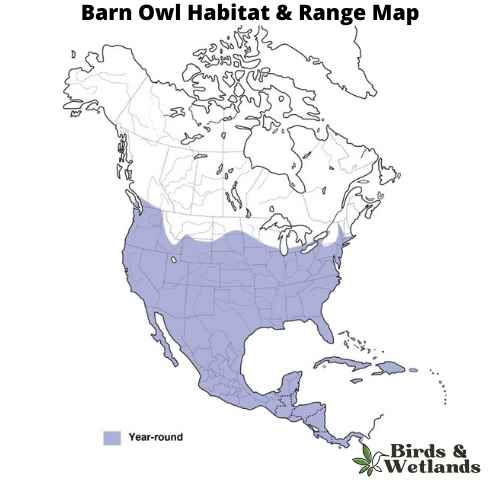
Barn Owl Sound
Scientific Name: Tyto alba
Length: 13 to 15 in
Wingspan: 31 to 37 in
Weight: 9.2 oz
The Barn Owl is a widespread species of owl known for its distinctive heart-shaped facial disc.
Barn Owls are medium-sized owls, they are pale overall with golden-brown wings and back, contrasted by a white face, chest, and belly. Their most notable feature is their heart-shaped facial disc, which helps channel sound to their ears.
Barn Owls are typically found in open habitats, including farmland, woodland, and marshes. They are named for their habit of nesting in human structures such as barns, church towers, and in the hollows of large trees. These owls are nocturnal, hunting at night and roosting during the day.
The diet of Barn Owls primarily consists of small mammals, particularly rodents such as mice and rats. They are known for their silent flight, which allows them to sneak up on their prey without detection.
Barn Owls have a unique nesting behavior. They do not build nests, but instead, lay their eggs directly on the bare surface of a secluded ledge or cavity. A female typically lays 4-7 eggs, and both parents help incubate the eggs and care for the chicks.
Snowy owl (Bubo scandiacus)
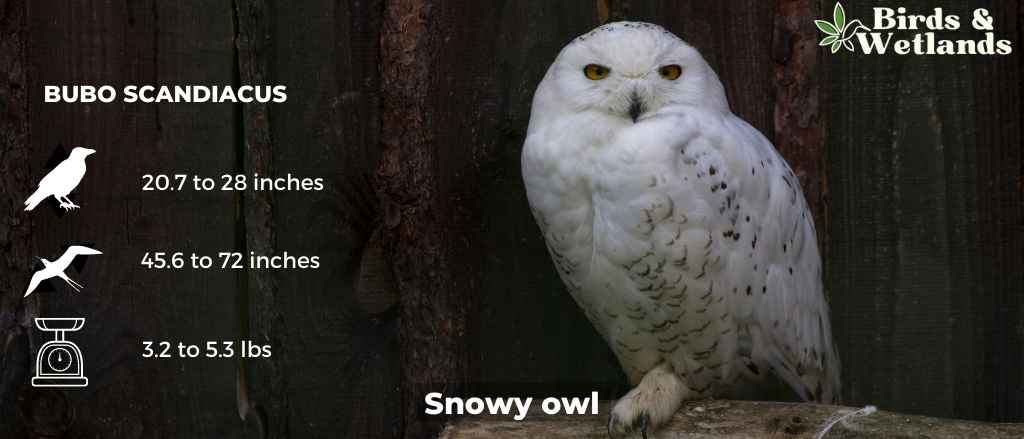
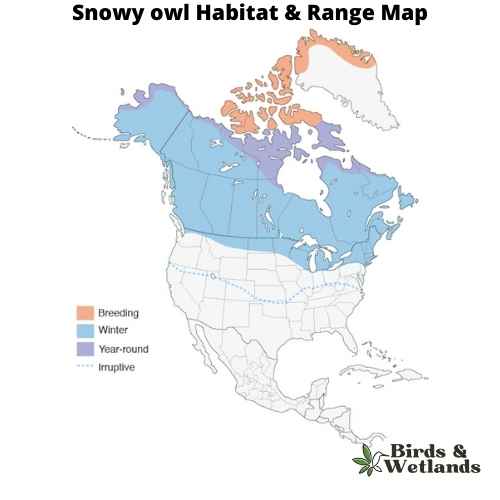
Snowy owl Sound
Scientific Name: Bubo scandiacus
Length: 20.7 to 28 in
Wingspan: 3 ft 10 in to 6 ft 0 in
Weight: 3.2lb to 5.3lb
The Snowy Owl, is of the most well-known species of owls, the Snowy Owl is renowned for its striking appearance and adaptations to its extreme environment.
Snowy Owls are medium sized birds that possess a rounded head, yellow eyes, and a black beak. The most distinctive feature of the Snowy Owl is its white plumage, which provides effective camouflage in its snowy habitat. Male Snowy Owls are often almost completely white, while females and younger owls have more extensive dark barring on their plumage.
Unlike many owl species, Snowy Owls are primarily diurnal, which means they are active during the day. This is an adaptation to life in the Arctic, where there can be 24 hours of daylight in the summer. Their diet mainly consists of small mammals, particularly lemmings, but they are known to eat a variety of animals including birds, fish, and even carrion when necessary.
Snowy Owls nest on the ground, usually on a mound or boulder. Their breeding success is closely tied to the availability of food, and in good years a single pair of owls can raise a large brood of chicks.
Short-eared Owl (Asio flammeus)


Short-eared Owl Sound
Scientific Name: Asio flammeus
Length: 13–17 in
Wingspan: 33 to 43 in
Weight: 7.3–16.8 oz
The Short-eared Owl is a medium-sized owl species with a wide distribution, found across North and South America, Europe, Asia, and many Pacific islands. Despite its name, the “ears” of the Short-eared Owl are not often visible, as they are small and tend to blend with the bird’s feathers.
The owls are predominantly brown with buff and white accents throughout their body and wings, and dark patches around their yellow eyes.
Short-eared Owls diet consists largely of small mammals, especially voles. However, they are opportunistic hunters and will also prey on a variety of other animals, including other birds, when available.
Their habitat is characterized by open areas like grasslands, marshes, and tundra. They nest on the ground, which is unusual for owls, and this makes them vulnerable to ground predators. As such, they often live in areas with tall grasses or other ground cover for protection.
The long-eared owl (Asio otus)

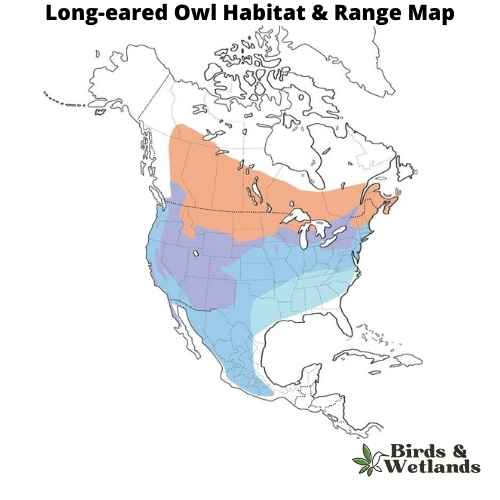
Long-eared Owl Sound
Scientific Name: Asio otus
Length: 12 and 16 in
Wingspan: 2 ft 10 in to 3 ft 4 in
Weight: 5.6 to 15.3 oz
The Long-eared Owl is a medium-sized owl species known for its distinctively long ear tufts, which can be raised or lowered depending on the bird’s mood or intention.
Long-eared Owls have mottled brown and cream plumage, which provides excellent camouflage among the trees. Their most distinctive features are their long, black-tipped ear tufts, which are set closer to the center of the head than in most other owl species.
These owls inhabit a wide variety of habitats, including deciduous and coniferous forests, woodlands, and even semi-deserts.
The Long-eared Owl’s diet primarily consists of small mammals, especially voles, but they will also take small birds and insects. They are skillful hunters, often capturing prey from a perch or in flight.
In terms of nesting behavior, Long-eared Owls do not construct their own nests, instead they take over old nests built by other bird species, usually those of corvids or other large birds. They lay an average of 4 to 5 eggs, which are incubated by the female while the male provides food.
Burrowing Owl (Athene cunicularia)

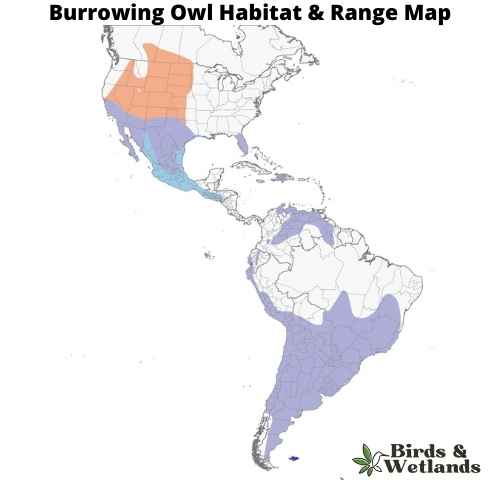
Burrowing Owl Sound
Scientific Name: Athene cunicularia
Length: 7–11 in
Wingspan: 20–24 in
Weight:5–8 oz
The Burrowing Owl is a small, long-legged species of owl found in North and South America. Known for its unusual habit of living in burrows in the ground.
Burrowing Owls have a rounded head with no ear tufts and bright yellow eyes. Their overall coloration is mottled brown and white with a distinct white “eyebrow” above each eye.
Their primary habitat includes open landscapes such as grasslands, deserts, agricultural areas, golf courses, and even airports. As their name suggests, these owls often reside in burrows, many of which are abandoned by prairie dogs, ground squirrels, or other burrowing animals. In some cases, they may also dig their own burrows.
Burrowing Owls diet consists mainly of small mammals and insects, but they also eat birds and reptiles.
Burrowing Owls have a unique nesting behavior. They lay their eggs in an underground burrow to protect them from predators and extreme weather. Clutch sizes range from 6 to 11 eggs, which are incubated for about a month before hatching.
Barred Owl (Strix varia)

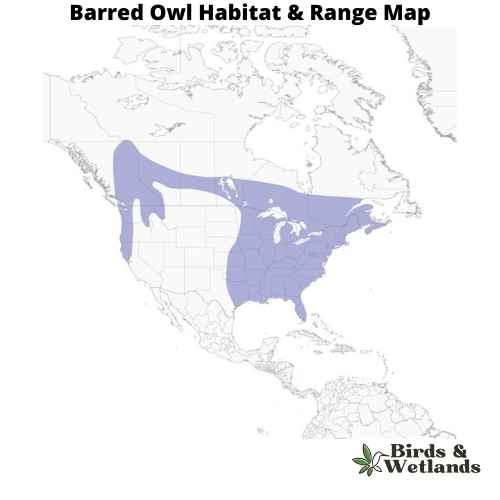
Barred Owl Sound
Scientific Name: Strix varia
Length: 40 to 63 cm (16 to 25 in)
Wingspan: 96 to 125 cm (38 to 49 in)
Weight: 468 to 1,150 g
The Barred Owl is a medium-sized owl with a barred pattern on its chest and belly. They have large yellow eyes that allow them to see well in low light conditions. Their ears are not very large which means they do not hear very well but they have excellent hearing abilities which allow them to detect sounds up to 1 mile away. Their feathers are brown and streaked with white, and they have black bars on their chests and wings.
Their habitats include forests, woodlands, orchards, parks, farmland and suburban backyards.
Barred Owls (also known as hoot owl) eat small mammals such as mice, rats and squirrels. They also eat insects such as beetles or grasshoppers. These owls hunt during the day when it is light out so that they can see their prey better than at night when they would be using senses other than sight like sound or smell to find their food source.
Barred owls are monogamous birds which means they mate for life. They build nests in trees or cavities on the ground and lay 2-4 eggs per year. The incubation period for these eggs lasts about 28 days before hatching takes place.
Northern Saw-whet Owl (Aegolius acadicus)

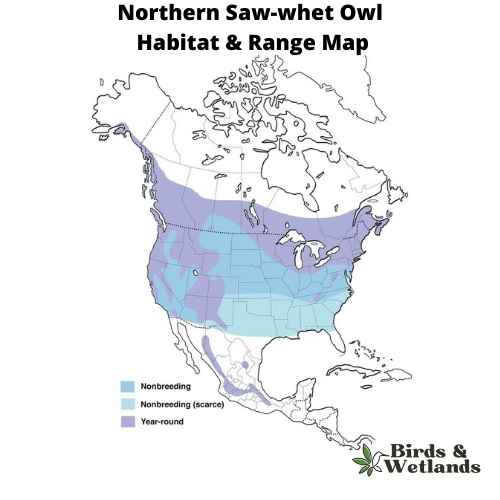
Northern Saw-whet Owl Sound
Scientific Name: Aegolius acadicus
Length: 17–22 cm (6.7–8.7 in)
Wingspan: 42–56.3 cm (16.5–22.2 in)
Weight: 54 to 151 g (1.9 to 5.3 oz)
The Northern Saw-whet Owl is a tiny, speckled gray owl and it’s one of the smallest owls in North America. It’s also known as the Little Owl or Wood Owl in some areas.
Northern Saw-whet Owls have dark brown eyes, white eyebrows, and yellow beak. It has brownish-grey feathers that are spotted with white. The owl’s legs are covered in feathers and appear nearly invisible when the bird is perched on a branch or tree.
In the winter they migrate south to warmer climates. They prefer to live in dense coniferous forest with large trees but will occasionally nest in shrubs or other vegetation that can protect them from predators.
The Northern Saw-whet Owl eats mice and voles (small rodents), small birds, frogs, salamanders, moles and shrews, but unlike most owls they chop their prey up and spread over a few meals. They will also eat insects like beetles and grasshoppers if they are available. It hunts from a perch at night using its excellent hearing to locate prey items within about 30 feet (9 meters) of its nest.
These owls nest in tree cavities usually located close to water sources such as lakes or rivers where they can find their food source (insects). They lay 2-4 eggs at one time which incubate for about 30 days before hatching.
Where to Spot Washington’s Birds of Prey
Mount Rainier National Park: This stunning national park is a hotspot for various birds of prey, including Red-Tailed Hawks, Peregrine Falcons, and Golden Eagles. The park’s vast wilderness and high peaks create an ideal environment for these raptors.
San Juan Islands: Particularly great for spotting Bald Eagles and Peregrine Falcons. The island chain’s diverse habitats – from its coastline to its forests – make it a favourite amongst bird watchers.
Nisqually National Wildlife Refuge: Situated along the Nisqually River Delta, this refuge is a great place to see a variety of raptors, including Northern Harriers and American Kestrels. The combination of freshwater and saltwater habitats attracts a wide array of bird species.
Ridgefield National Wildlife Refuge: Located in the Columbia River floodplain, this refuge is an important stopover point for migrating raptors. It hosts species such as the Cooper’s Hawk, Red-Tailed Hawk, and occasionally, the Northern Goshawk.
Olympic National Park: Spanning various ecosystems, from mountain ridges to old-growth forest and rugged coastline, this park offers bird watchers the chance to spot species like the Golden Eagle, Peregrine Falcon, and several owl species. The Hoh Rain Forest and Hurricane Ridge are particularly good viewing locations.
Washington, with its lush forests and coastal regions, is home to an array of birds of prey. Experience the untamed beauty symbolized by Oregon’s Feathered Predators. Or, venture east to Idaho’s birds of prey, where the Sky Hunters reflect the state’s diverse landscapes. Learn more about these birds with our ultimate Guide to American Birds of Prey.

